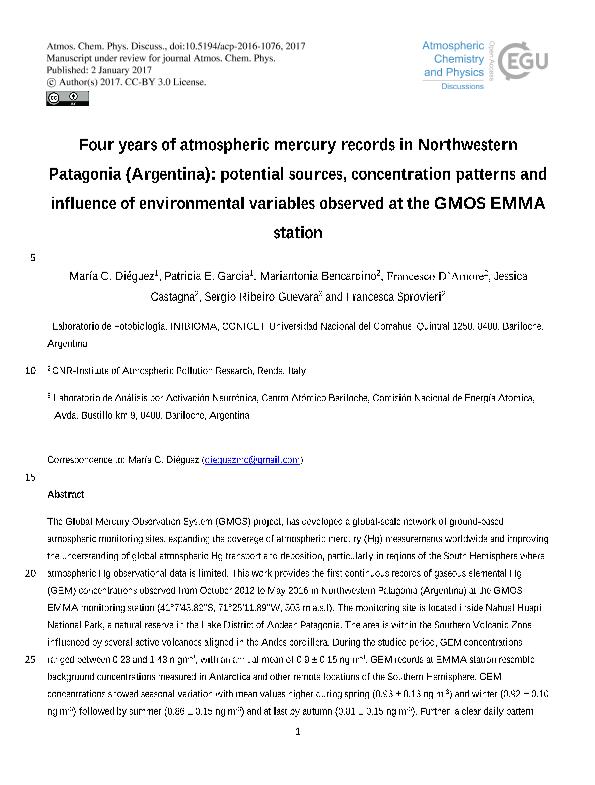Mostrar el registro sencillo del ítem
dc.contributor.author
Dieguez, Maria del Carmen

dc.contributor.author
Garcia, Patricia Elizabeth

dc.contributor.author
Bencardino, Mariantonia
dc.contributor.author
D’Amore, Francesco
dc.contributor.author
Castagna, Jessica
dc.contributor.author
Ribeiro Guevara, Sergio
dc.contributor.author
Sprovieri, Francesca
dc.date.available
2018-08-31T20:06:28Z
dc.date.issued
2017-01
dc.identifier.citation
Dieguez, Maria del Carmen; Garcia, Patricia Elizabeth; Bencardino, Mariantonia; D’Amore, Francesco; Castagna, Jessica; et al.; Four years of atmospheric mercury records in Northwestern Patagonia (Argentina): potential sources, concentration patterns and influence of environmental variables observed at the GMOS EMMA station; Copernicus Publications; Atmospheric Chemistry and Physics Discussions; 1-2017; 1-18
dc.identifier.issn
1680-7375
dc.identifier.uri
http://hdl.handle.net/11336/57961
dc.description.abstract
The Global Mercury Observation System (GMOS) project, has developed a global-scale network of ground-based atmospheric monitoring sites, expanding the coverage of atmospheric mercury (Hg) measurements worldwide and improving the understanding of global atmospheric Hg transport and deposition, particularly in regions of the South Hemisphere where atmospheric Hg observational data is limited. This work provides the first continuous records of gaseous elemental Hg (GEM) concentrations observed from October 2012 to May 2016 in Northwestern Patagonia (Argentina) at the GMOS EMMA monitoring station (41°7´43.82" S, 71°25´11.89" W, 803 m a.s.l). The monitoring site is located inside Nahuel Huapi National Park, a natural reserve in the Lake District of Andean Patagonia. The area is within the Southern Volcanic Zone, influenced by several active volcanoes aligned in the Andes cordillera. During the studied period, GEM concentrations ranged between 0.23 and 1.43 ng m−3, with an annual mean of 0.9 ± 0.15 ng m−3. GEM records at EMMA station resemble background concentrations measured in Antarctica and other remote locations of the Southern Hemisphere. GEM concentrations showed seasonal variation with mean values higher during spring (0.93 ± 0.13 ng m−3) and winter (0.92 ± 0.10 ng m−3) followed by summer (0.86 ± 0.15 ng m−3) and at last by autumn (0.81 ± 0.15 ng m−3). Further, a clear daily pattern was observed, with higher GEM levels during day-time than at night-time across all seasons. Multivariate analyses showed that GEM levels are chiefly determined by meteorological parameters, and, in particular by the westerly winds which represented the most influential variable on GEM records. In order to investigate the potential impact of natural and/or anthropogenic emission sources as well as the role played by the long-range transport on GEM levels, analyses of HYSPLIT backward trajectories (BWT) were carried out for different periods characterized by low and high GEM concentrations. The BWT analysis highlighted the influence of clean oceanic air masses and also of the local and regional active volcanoes in the Andes cordillera.
dc.format
application/pdf
dc.language.iso
eng
dc.publisher
Copernicus Publications

dc.rights
info:eu-repo/semantics/openAccess
dc.rights.uri
https://creativecommons.org/licenses/by-nc-sa/2.5/ar/
dc.subject
Mercurio
dc.subject
Atmósfera
dc.subject
Especiacion
dc.subject
Patagonia
dc.subject.classification
Meteorología y Ciencias Atmosféricas

dc.subject.classification
Ciencias de la Tierra y relacionadas con el Medio Ambiente

dc.subject.classification
CIENCIAS NATURALES Y EXACTAS

dc.title
Four years of atmospheric mercury records in Northwestern Patagonia (Argentina): potential sources, concentration patterns and influence of environmental variables observed at the GMOS EMMA station
dc.type
info:eu-repo/semantics/article
dc.type
info:ar-repo/semantics/artículo
dc.type
info:eu-repo/semantics/publishedVersion
dc.date.updated
2018-08-31T13:48:03Z
dc.journal.pagination
1-18
dc.journal.pais
Alemania

dc.journal.ciudad
Munich
dc.description.fil
Fil: Dieguez, Maria del Carmen. Consejo Nacional de Investigaciones Científicas y Técnicas. Centro Científico Tecnológico Conicet - Patagonia Norte. Instituto de Investigaciones en Biodiversidad y Medioambiente. Universidad Nacional del Comahue. Centro Regional Universidad Bariloche. Instituto de Investigaciones en Biodiversidad y Medioambiente; Argentina
dc.description.fil
Fil: Garcia, Patricia Elizabeth. Consejo Nacional de Investigaciones Científicas y Técnicas. Centro Científico Tecnológico Conicet - Patagonia Norte. Instituto de Investigaciones en Biodiversidad y Medioambiente. Universidad Nacional del Comahue. Centro Regional Universidad Bariloche. Instituto de Investigaciones en Biodiversidad y Medioambiente; Argentina
dc.description.fil
Fil: Bencardino, Mariantonia. Institute of Atmospheric Pollution Research; Italia
dc.description.fil
Fil: D’Amore, Francesco. Institute of Atmospheric Pollution Research; Italia
dc.description.fil
Fil: Castagna, Jessica. Institute of Atmospheric Pollution Research; Italia
dc.description.fil
Fil: Ribeiro Guevara, Sergio. Comisión Nacional de Energía Atómica. Centro Atómico Bariloche; Argentina
dc.description.fil
Fil: Sprovieri, Francesca. Institute of Atmospheric Pollution Research; Italia
dc.journal.title
Atmospheric Chemistry and Physics Discussions
dc.relation.alternativeid
info:eu-repo/semantics/altIdentifier/doi/https://dx.doi.org/10.5194/acp-2016-1076
dc.relation.alternativeid
info:eu-repo/semantics/altIdentifier/url/https://www.atmos-chem-phys-discuss.net/acp-2016-1076/
Archivos asociados
